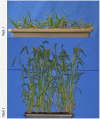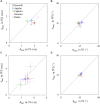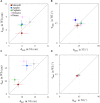Architectural Response of Wheat Cultivars to Row Spacing Reveals Altered Perception of Plant Density
- PMID: 31447868
- PMCID: PMC6692534
- DOI: 10.3389/fpls.2019.00999
Architectural Response of Wheat Cultivars to Row Spacing Reveals Altered Perception of Plant Density
Abstract
Achieving novel improvements in crop management may require changing interrow distance in cultivated fields. Such changes would benefit from a better understanding of plant responses to the spatial heterogeneity in their environment. Our work investigates the architectural plasticity of wheat plants in response to increasing row spacing and evaluates the hypothesis of a foraging behavior in response to neighboring plants. A field experiment was conducted with five commercial winter wheat cultivars possessing unique architectures, grown under narrow (NI, 17.5 cm) or wide interrows (WI, 35 cm) at the same population density (170 seeds/m2). We characterized the development (leaf emergence, tillering), the morphology (dimension of organs, leaf area index), and the geometry (ground cover, leaf angle, organ spreading, and orientation). All cultivars showed a lower number of emerged tillers in WI compared to NI, which was later partly compensated by lower tiller mortality. Besides, the upper leaf blades were larger in WI. Finally the leaf area index at flowering showed little difference between WI and NI treatments. The rate of leaf emergence and the final leaf number were higher in WI compared to NI, except for one cultivar. Around the start of stem elongation, pseudo-stems were more erect in WI, while around the time of flowering, stems were more inclined and leaves were more planophile. Cultivars differed in their degrees of responses, with one appearing to prospect more specifically within the interrow space in WI treatment. Altogether, our results suggest that altering interrow distance leads to changes in the perceived extent of competition by plants, with responses first mimicking the effect of a higher plant density and later the effect of a lower plant density. Only one cultivar showed responses that suggested a perception of the heterogeneity of the environment. These findings improve our understanding of plant responses to spatial heterogeneity and provide novel information to simulate light capture in plant 3D models, depending on cultivar behavior.
Keywords: architectural response; leaf angle; plasticity; row spacing effect; space prospection; stem angle; tillering; wheat.
Figures









References
-
- Abichou M., Dornbusch T., Chambon C., Gouache D., de Solan B., Andrieu B. (2018). Parametrizing wheat leaf and tiller dynamics for structural plant models. Field Crop Res. 218 213–230. 10.1016/j.fcr.2018.01.010 - DOI
-
- Adam B., Sinoquet H., Godin C., Donès N. (1999). 3A–Software for The Acquisition of Plant Architecture. Clermont-Ferrand: INRA.
-
- Alzueta I., Abeledo L. G., Mignone C. M., Miralles D. J. (2012). Differences between wheat and barley in leaf and tillering coordination under contrasting nitrogen and sulfur conditions. Eur. J. Agron. 41 92–102. 10.1016/j.eja.2012.04.002 - DOI
-
- Araus J. L., Reynolds M. P., Acevedo E. (1993). Leaf posture, grain-yield, growth, leaf structure, and carbon-isotope discrimination in wheat. Crop Sci. 33 1273–1279. 10.2135/cropsci1993.0011183X003300060032x - DOI
-
- Baccar R. (2011). Plasticity of Winter WHEAT ARCHItecture Modulated by Sowing Date and Plant Population DENsity and Its Effect on Septoria Tritici Epidemics. Ph.D. thesis, University AgroParisTech, Paris.
LinkOut - more resources
Full Text Sources

